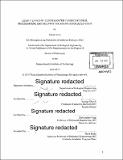Highly efficient Cas9 mediated transcriptional programming and delivery via Adeno-Associated Virus
Author(s)
Vora, Suhani
DownloadFull printable version (28.20Mb)
Other Contributors
Massachusetts Institute of Technology. Department of Biological Engineering.
Advisor
George Church and Christopher Voigt.
Terms of use
Metadata
Show full item recordAbstract
The RNA-guided bacterial nuclease Cas9 can be reengineered as a programmable transcription factor by a series of modifications to the Cas9 protein and the direct fusion of a synthetic transcriptional activation domain (AD). However, the modest levels of gene activation achieved by first generation Cas9 activators limited their potential applications. We describe the development of a versatile, improved transcriptional regulator through the rational design of a tripartite activator, VP64-p65-RTA (VPR), fused to Cas9. We demonstrate its utility in activating expression of endogenous coding and non-coding genes, and showcase the ability to target several genes simultaneously. As a further demonstration of the tools efficacy, we stimulate neuronal differentiation of induced pluripotent stem cells (iPSCs), validating the biologically relevant levels of activation attained by this tool. Beyond applications to cellular programming, Cas9 transcriptional and epigenetic activators hold tremendous promise for in vivo gain of function studies as well as therapeutics. However, the most convenient and only approved vector for human delivery is the Adeno-Associated Virus (AAV). This convenient virus allows for targeting of various tissue types with high efficiency and little risk of integration or immunogenicity. Unfortunately, the virus is limited to a genomic payload of 4.7kb, which can be pushed to 5kb but not much further. The most commonly used Cas9 ortholog from S. pyogenes is 4.2kb alone, leaving very little room for an additional promoter let alone an sgRNA expression cassette or accessory activation domains. Here, we detail a single-vector system for delivery of a miniaturized, potent Cas9 activator for AAV mediated transcriptional regulation in neuronal, hepatic, gonadal, and muscle derived cell lines on a panel of genomic targets.
Description
Thesis: Ph. D., Massachusetts Institute of Technology, Department of Biological Engineering, 2017. Cataloged from PDF version of thesis. Includes bibliographical references (pages 150-157).
Date issued
2017Department
Massachusetts Institute of Technology. Department of Biological EngineeringPublisher
Massachusetts Institute of Technology
Keywords
Biological Engineering.